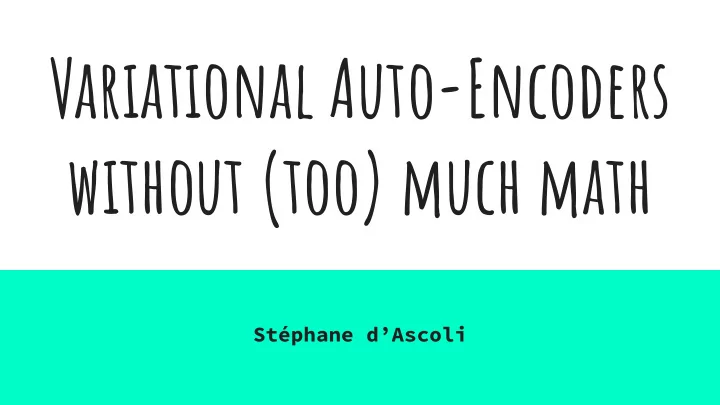

Variational Auto-Encoders without (too) much math Stéphane d’Ascoli
Roadmap 1. A reminder on auto-encoders a. Basics b. Denoising and sparse encoders c. Why do we need VAEs ? 2. Understanding variational auto-encoders a. Key ingredients b. The reparametrization trich c. The underlying math 3. Applications and perspectives a. Disentanglement b. Adding a discrete condition c. Applications d. Comparison with GANs 4. Do it yourself in PyTorch a. Build a basic denoising encoder b. Build a conditional VAE
Auto-Encoders
Basics
Denoising and Sparse Auto-Encoders Denoising : Sparse : enforces specialization of Contractive : enforces that close inputs hidden units give close outputs
Why do we need VAE ? VAE’s are used as generative models : sample a latent vector, decode and you have a new sample Q : Why can’t we use normal auto-encoders ? A : If we choose an arbitrary latent vector, we get garbage Q : Why ? A : Because latent space has no structure !
Variational Auto-Encoders
Key Ingredients Generative models : unsupervised learning, aim to learn the distribution underlying the input data VAEs : Map the complicated data distribution to a simpler distribution (encoder) we can sample from (Kingma & Welling 2014) to generate images (decoder)
First Ingredient : Encode into Distributions Q : Why encode into distributions rather than discrete values ? A : To impose that close values of z give close values of x : latent space becomes more meaningful Now if we sample z anywhere inside the distribution obtained with x, we reconstruct x. But we want to generate new images ! Problem : if we sample z elsewhere, we get garbage...
Second Ingredient : impose structure Q : How can we make the images generated look realistic whatever the sampled z ? A : Make sure that Q(z|x) for different x’s are close together !
Second Ingredient : impose structure Q : How do we keep the distributions close together ? A : By enforcing the overall distribution in latent space to follow a standard Gaussian prior Q : How ? A : KL divergence !
The Reparametrization Trick Q : How can we backpropagate when one of the nodes is non-deterministic ? A : Use the reparametrization trick !
The Underlying Information Theory
Proof of the Lower Bound Q : Why “variational” auto-encoders ? A : Relies on a variational method Consider a tractable distribution Q instead Intractable ! >0 Regularizer Reconstruction loss > ELBO
VAEs in Practice
Disentanglement : Beta-Vae We saw that the objective function is made of a reconstruction and a regularization part. By adding a tuning parameter we can control the tradeoff. If we increase beta: - The dimensions of the latent representation are more disentangled - But the reconstruction loss is less good
Generating Conditionally : CVAEs Add a one-hot encoded vector to the latent space and use it as categorical variable, hoping that it will encode discrete features in data (number in MNIST) Q : The usual reparametrization trick doesn’t work here, because we need to sample discrete values from the distribution ! What can we do ? A : Gumbel-Max trick Q : How do I balance the regularization terms for the continuous and discrete parts ? A : Control the KL divergences independently
Applications Image generation : Dupont et al. 2018 Text generation : Bowman et al. 2016
Comparison with GANS VAE GAN Easy metric : reconstruction loss Cleaner images Interpretable and disentangled latent space Low interpretability Easy to train Tedious hyperparameter searching Noisy generation Clean generation
Towards a Mix of the Two ?
Do It Yourself In Pytorch
Auto-Encoder 1. Example: a simple fully-connected auto-encoder 2. DIY: implement a denoising convolutional auto-encoder for MNIST
Variational Auto-Encoder 1. Example: a simple VAE 2. DIY: implement a conditional VAE for MNIST
Questions
Recommend
More recommend